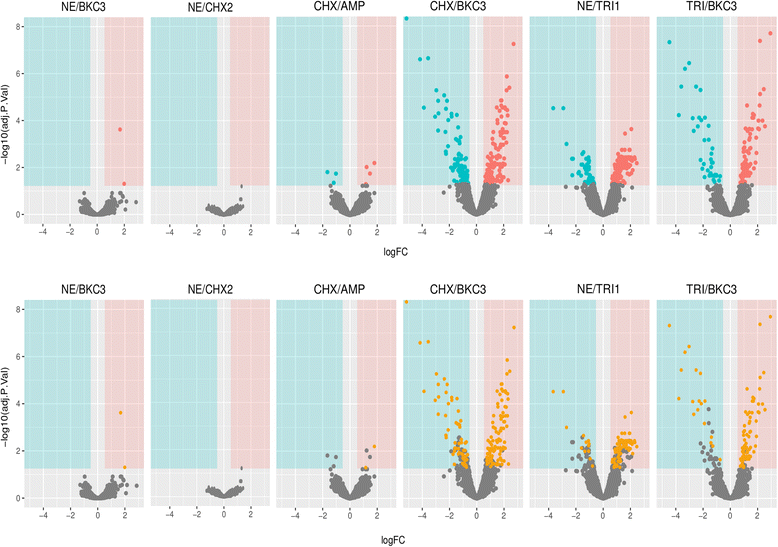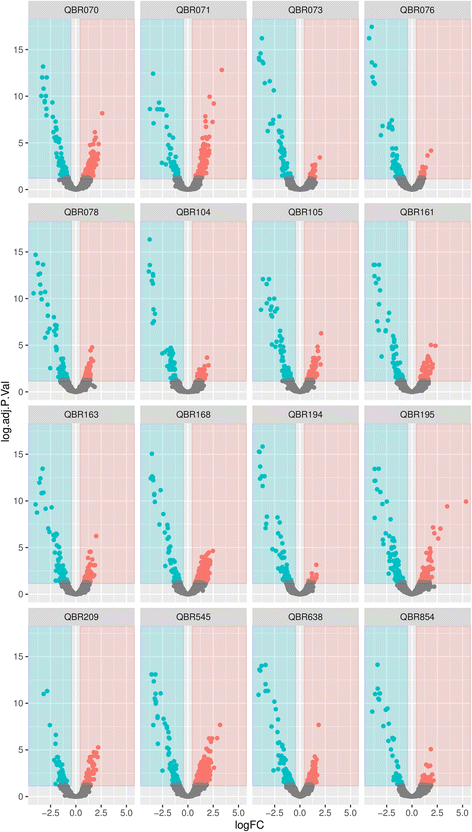Multiple adaptive routes of Salmonella enterica Typhimurium to biocide and antibiotic exposure
- PMID: 27411385
- PMCID: PMC4943003
- DOI: 10.1186/s12864-016-2778-z
Multiple adaptive routes of Salmonella enterica Typhimurium to biocide and antibiotic exposure
Abstract
Background: Biocides and antibiotics are used to eradicate or prevent the growth of microbial species on surfaces (occasionally on catheters), or infected sites, either in combination or sequentially, raising concerns about the development of co-resistance to both antimicrobial types. The effect of such compounds on Salmonella enterica, a major food-borne and zoonotic pathogen, has been analysed in different studies, but only few works evaluated its biological cost, and the overall effects at the genomic and transcriptomic levels associated with diverse phenotypes resulting from biocide exposure, which was the aim of this work.
Results: Exposure to triclosan, clorhexidine, benzalkonium, (but not to hypochlorite) resulted in mutants with different phenotypes to a wide range of antimicrobials even unrelated to the selective agent. Most biocide-resistant mutants showed increased susceptibility to compounds acting on the cell wall (β-lactams) or the cell membranes (poly-L-lysine, polymyxin B, colistin or toxic anions). Mutations (SNPs) were found in three intergenic regions and nine genes, which have a role in energy production, amino acids, carbohydrates or lipids metabolism, some of them involved in membrane transport and pathogenicity. Comparative transcriptomics of biocide-resistant mutants showed over-expression of genes encoding efflux pumps (sugE), ribosomal and transcription-related proteins, cold-shock response (cpeE) and enzymes of microaerobic metabolism including those of the phosphotransferase system. Mainly ribosomal, metabolic and pathogenicity-related genes had affected expression in both in vitro-selected biocide mutants and field Salmonella isolates with reduced biocide susceptibility.
Conclusions: Multiple pathways can be involved in the adaptation of Salmonella to biocides, mainly related with global stress, or involving metabolic and membrane alterations, and eventually causing "collateral sensitivity" to other antimicrobials. These changes might impact the bacterial-environment interaction, imposing significant bacterial fitness costs which may reduce the chances of fixation and spread of biocide resistant mutants.
Keywords: Antimicrobial susceptibility; Biocide resistance; Collateral sensitivity; Transcriptomics; WGS.
Figures




Similar articles
-
Polymorphic variation in susceptibility and metabolism of triclosan-resistant mutants of Escherichia coli and Klebsiella pneumoniae clinical strains obtained after exposure to biocides and antibiotics.Antimicrob Agents Chemother. 2015;59(6):3413-23. doi: 10.1128/AAC.00187-15. Epub 2015 Mar 30. Antimicrob Agents Chemother. 2015. PMID: 25824225 Free PMC article.
-
Commonly used farm disinfectants can select for mutant Salmonella enterica serovar Typhimurium with decreased susceptibility to biocides and antibiotics without compromising virulence.J Antimicrob Chemother. 2007 Dec;60(6):1273-80. doi: 10.1093/jac/dkm359. Epub 2007 Sep 25. J Antimicrob Chemother. 2007. PMID: 17897935
-
Biocide exposure in extended-spectrum β-lactamase-producing Klebsiella pneumoniae: effect on increased biocide and antibiotic MICs, genetic changes, and fitness cost.J Appl Microbiol. 2025 Jun 2;136(6):lxaf121. doi: 10.1093/jambio/lxaf121. J Appl Microbiol. 2025. PMID: 40424514
-
Susceptibility of antibiotic-resistant cocci to biocides.Symp Ser Soc Appl Microbiol. 2002;(31):158S-162S. Symp Ser Soc Appl Microbiol. 2002. PMID: 12481840 Review.
-
Efflux-mediated tolerance to cationic biocides, a cause for concern?Microbiology (Reading). 2022 Nov;168(11). doi: 10.1099/mic.0.001263. Microbiology (Reading). 2022. PMID: 36748532 Review.
Cited by
-
Efflux drug transporters at the forefront of antimicrobial resistance.Eur Biophys J. 2017 Oct;46(7):647-653. doi: 10.1007/s00249-017-1238-2. Epub 2017 Jul 14. Eur Biophys J. 2017. PMID: 28710521 Free PMC article. Review.
-
Relationship of Triamine-Biocide Tolerance of Salmonella enterica Serovar Senftenberg to Antimicrobial Susceptibility, Serum Resistance and Outer Membrane Proteins.Int J Mol Sci. 2017 Jul 11;18(7):1459. doi: 10.3390/ijms18071459. Int J Mol Sci. 2017. PMID: 28696348 Free PMC article.
-
Resilient by Design: Environmental Stress Promotes Biofilm Formation and Multi-Resistance in Poultry-Associated Salmonella.Microorganisms. 2025 Aug 3;13(8):1812. doi: 10.3390/microorganisms13081812. Microorganisms. 2025. PMID: 40871316 Free PMC article.
-
Evolutionary toxicology in an omics world.Evol Appl. 2017 Feb 20;10(8):752-761. doi: 10.1111/eva.12462. eCollection 2017 Sep. Evol Appl. 2017. PMID: 29151868 Free PMC article.
-
Disinfectants and antiseptics: mechanisms of action and resistance.Nat Rev Microbiol. 2024 Jan;22(1):4-17. doi: 10.1038/s41579-023-00958-3. Epub 2023 Aug 30. Nat Rev Microbiol. 2024. PMID: 37648789 Review.
References
-
- Condell O, Iversen C, Cooney S, Power KA, Walsh C, Burgess C, Fanning S. Efficacy of biocides used in the modern food industry to control Salmonella enterica, and links between biocide tolerance and resistance to clinically relevant antimicrobial compounds. Appl Environ Microbiol. 2012;78:3087–3097. doi: 10.1128/AEM.07534-11. - DOI - PMC - PubMed
-
- Beier RC, Anderson PN, Hume ME, Poole TL, Duke SE, Crippen TL, Sheffield CL, Caldwell DJ, Byrd JA, Anderson RC, Nisbet DJ. Characterization of Salmonella enterica Isolates from Turkeys in Commercial Processing Plants for Resistance to Antibiotics, Disinfectants, and a Growth Promoter. Foodborne Pathog Dis. 2011;8:593–600. doi: 10.1089/fpd.2010.0702. - DOI - PubMed
Publication types
MeSH terms
Substances
Grants and funding
LinkOut - more resources
Full Text Sources
Other Literature Sources
Medical

